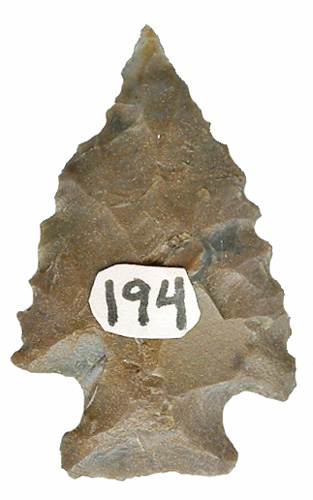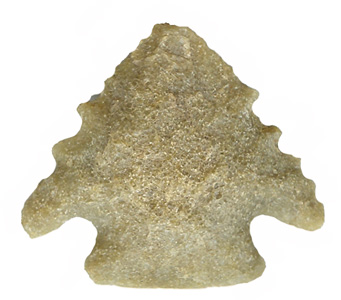



Point Type:
PALMER
Also See: Amos
Corner Notched, Barbee Corner Notched, Brewerton Corner
Notched , Cave Spring, Charleston Corner Notched,
Crawford Creek Notched, Kirk Corner Notched, Kirk Stemmed
, Pinetree, Rice Concave Base, St.
Albans,
Stilwell
Location: Eastern and Southeastern States
Associated Dates: 9000 - 8000 B.P. -
Early Archaic
Morphology:
Corner
Notched
General Description: The Palmer point type is a small
sized point having corner notches. The blade is triangular in shape having
straight to slightly concave or convex edges that are mostly serrated (some examples are deeply
serrated). The stem is short and expanded and has a straight basal edge. The stem edges are ground and thinned. The shoulders are
strongly barbed. The cross-section is biconvex
.
The points are made by pressure flaking. The
serrations appear to have been made
at the time when the point was finished, since the flake scars produced by
the serrations are long an overlap toward the center of the blade. The
notches are formed by the removal of deep broad flakes. Local materials were
used the manufacture of the Palmer type.
The Palmer is found in the
Carolinas, and are also found in Georgia, Tennessee, Alabama, Virginia, West
Virginia, Kentucky, Mississippi, Louisiana, Arkansas, northeast Texas and
southeastern Oklahoma. Coe indicated that the type could also be found
northward along the Atlantic Coast into New England.
The maximum length
of the Palmer is 60 mm; minimum 28 mm and average being 35 mm. Maximum
width is 25 mm, minimum 15 mm and average being 20 mm. Maximum thickness is 12
mm, minimum 5 mm and average being 8 mm.
Perino suggests a relationship
to the Kirk Stemmed point exists.
The Palmer type was named by Joffre Lanning Coe in 1964 for Palmer Mountain
which was near the Hardaway Site in Piedmont North Carolina.
About The Point Above (left): The small Palmer pictured at the top left
hand side of this page, was found along the Maryland shore. It is made
from a deep dark brownish red jasper material that has a slight gloss
and has some darker brown streaks. The blade surface has some very nice flaking
and the blade is quite thin and serrated. The base is mildly ground. The specimen measures 30 mm in length, 18.3 mm
wide across the barbs, and is only 5.6 mm at its thickest point
at mid blade. The base tapers down to 2.3 mm in thickness. The stem length
is 6.5 mm long and is 11.6 mm wide.
Catalog Number 194-45-L
About The Point Above (right):
The small Palmer pictured at the top right hand side of
this page, was found along the Maryland shore. It is made from
a coffee colored tan grainy quartzite material. This point shows
remarkable knapping extpertise considering the material and the size of the
blade. The base and stem are ground. The blade tip
has been historically reduced in size due to a chip. The specimen
measures 28 mm in length, 33 mm wide across the barbs, and is 6.5
mm at its thickest point at mid blade. The base tapers down to 4.7 mm in
thickness. The stem length is 7.7 mm long and is 19.6 mm
wide. Catalog Number
232-45-L
References: Cambron &
Hulse, Coe, Dragoo, Hranicky
(1, 2, 3), Justice (1), Overstreet, Perino
(1)
© Copyright 1997 - 2009 LITHICS-Net WWW.LITHICSNET.COM
Use your Browser's BACK Button to return to the LITHICS-Net Index.